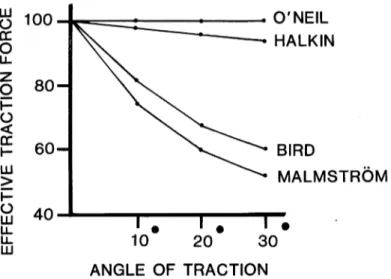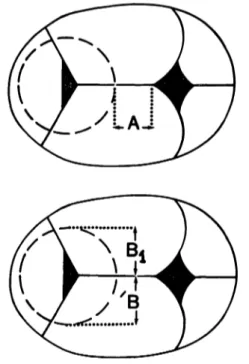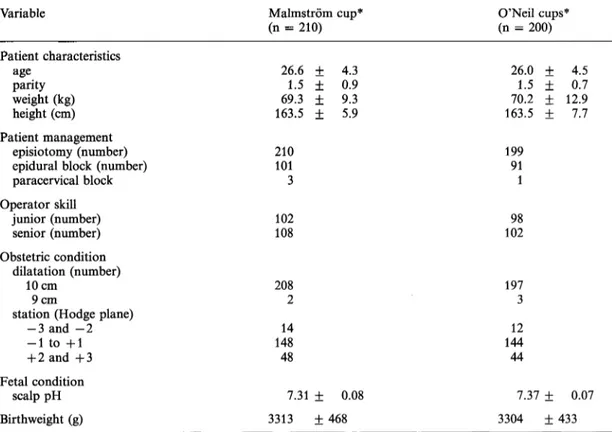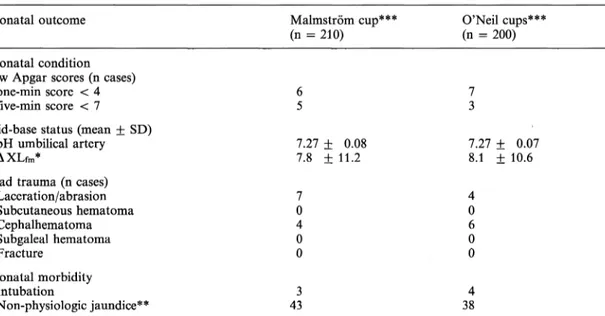Original articles
J. Perinat. Med.
15 (1987) 129
A randomized study of two cups for vacuum extraction
Michel Thiery, Rudy Van Den Broecke, Guy Kermans, Walter Parewijck, Marc Dhont, Maureen Vanlancker, Henry Van Kets, Paul Defoort, Robert Derom, and Piet Vanhaesebrouck
1Department of Obstetrics and Gynecology and department of Pediatrics, University Hospital, Ghent, Belgium
1 Introduction
MALMSTRÖM designed the first "genuine" vac- uum extractor in 1953 [8]. In Europe, as in most parts of the Third World, the ventouse is now a popular extraction device that has re- placed obstetric forceps in many clinics.
Two imperfections have been ascribed to the Malmström instrument: (a) its lack of maneu- verability and (b) its relative ineffectiveness if pulled obliquely. These drawbacks have pro- mpted numerous investigators to modify the design of the traditional cup in an attempt to overcome these alleged inconveniences [13].
Lack of maneuverability: If Malmström's cup is positioned in the conventional way [9], i. e., applied to the most accessible part of a deflexed and/or asynclytic head, the extraction force tends to fix the head in this unfavorable atti- tude, thus maintaining the relative dispropor- tion [2]. If, on the contrary, the cup is posi- tioned over the posterior fontanelle in the mid- line (flexing median or "ideal" application ac- cording to BIRD [2]), the chances are good that the initial pull(s) will correct any postural devia- tion and thus make extraction easier and safer.
Because the centrally attached suction pipe may hinder ideal application of the Malmström cup, Bird [1] connected the traction chain to the center of the cup and moved the pipe excentri- cally. However, the laterally placed tube still
impeded ideal cup application when the posi- tion of the occiput was posterior or lateral, and therefore the author moved the suction pipe to the flange of the cup [2]. Bird called one of his models the anterior cup (OA) and the other the posterior (OP) cup.
Direction of pull: When the operator pulls in an oblique direction the effective tractional force is reduced proportionally to the angle of trac- tion [6]. As a result, the cup tends to tilt and may even become detached from the fetal scalp [7], thus decreasing the efficiency of the proce- dure and increasing the risk of damage to the fetal head. Because neither of the Bird models substantially neutralizes the effects of the tilting phenomenon (figure 1), O'NEIL et al. [11]
devised a highly imaginative rotating traction collar (figure 2) that allows two planes of move- ment and ensures that within a 70-degree range of pull the line of traction is always through the center of the vacuum surface and the effective traction remains constant (figure 1). By com- bining the principle underlying Bird's modified cups with that of the rotating collar, O'Neil created a set of cups (OA and OP) which theor- etically would overcome the two main draw- backs of the Malmström device (figure 3).
To check these claims we conducted a rando-
mized controlled trial comparing the efficiency
and safety of the conventional instrument with
those of the O'Neil models.
8 100 . O'NEIL
HALKIN
BIRD
MALMSTRÖM
20 30 ANGLE OF TRACTION
Figure 1. Effective traction force according to angle of traction for a variety of suction cup models (Reproduced, with permission, from Thiery 1985).
Figure 2. Cross-section of O'Neil's cup. Metal rod (T) curved to form the perimeter of a circle about D. This rod is mounted on a circular plate (U) which rotates against its bearing (S). A ring of the traction chain (W) slides on T along the perimeter of the circle with its center at D. This mechanism allows two planes of movement and ensures that the line of traction is always through D. (Reproduced, with permission, from O'Neil et al. 1981).
Figure 3. O'Neil's OP (left) and OA cups with cord attached to rotating collar (Courtesy of GO Medical Industries, Subiaco, Western Australia).
2 Methods and subjects
Between January 30, 1984 and September 30, 1985, 410 elective vacuum extractions were at- tempted with either a 50-mm diameter Malmström cup (n = 210) or the standard 55- mm diameter OA or OP O'Neil cup (n = 200).
Allocation of cup type was on the basis of randomization. When planning the extraction procedure, the operator received from the mid- wife either a conventional ventouse or a set of O'Neil cups. In the latter instance it was up to the operator to make the appropriate choice between the OA and the OP cup on the basis of the findings of the pelvic examination: OP for a fetus in the occipito-posterior of occipito- lateral position, OA for other positions.
Operators with various degrees of expertise par- ticipated in the trial, 49% of the procedures being performed by junior staff. Operators were free to enter candidates provided the woman was a normal term (> 38 full gestational weeks) gravida, fully dilated, and carrying an appar- ently healthy singleton fetus in cephalic presen- tation.
For assessment of the condition of the fetus immediately prior to the attempted extraction a scalp blood sample was collected before appli- cation of the suction cup. Evaluation of the infant's status at birth was based on clinical and biochemical parameters. The head of all of the newborns was inspected by two of us (MT and HVK) between 24 and 48 hours post-deliv- ery.
For the evaluation of cup position, two values were used: the degree of flection, expressed as the distance (cm) between the edge of the cup and the anterior fontanelle and the degree of synclitism, as the difference between the dis- tances (cm) from cup edge to sagittal suture (figure 4).
Currently accepted standards were applied for the extraction procedure. The highest possible level of negative pressure (usually —0.8 kg/cm
2) was obtained in a single step, usually requiring 1—2 minutes, with an electric vacuum pump controlled by a foot pedal. After the operator had made certain that no soft tissue or any
Figure 4. Determinations for assessment of cup position.
Top: distance between cup edge and anterior fontanelle (A). Bottom: difference between distances from cup ed- ges to sagittal diameter (B — Bi or Bi — B).
foreign body (e. g., scalp electrode or intrauter- ine pressure recording catheter) was present between the rim of the cup and the fetal scalp, a trial traction was performed to confirm pro- per cup attachment. During the extraction pro- per, the operator had to respect the following rules of thumb [10]: synchronization of pulling with uterine contractions; adjustment of trac- tion direction to pelvic axis; pressing of the fetal head toward the sacrum during pulls using the Dreifingergriff [5]; and, most important of all, restriction of the number of pulls and the duration of the extraction. According to depart- mental policy, a "freshman" is asked to stop the procedure after 3 to 4 full pulls have failed to complete the ventouse delivery, and to call on a senior staff member for reevaluation.
Immediately after the delivery, details of each
procedure were recorded by the operator on
specially designed charts. Neonatal and puer-
peral data were entered on the same document and completed at discharge. For inter-group comparison, the Student t test and chi-square tests were used.
The two instrument groups were comparable as to patient characteristics and management, operator skill, and obstetric and fetal condi- tions at cup application (table I).
3 Results
Efficiency: Seven (1.7%) of the intended vac- uum extractions were to be considered failures because the patient was not delivered with the cup model allocated, and the failure rate did
not differ significantly between the two models investigated (table II). Most of the failures were overcome by switching to the other suction cup model. One patient was delivered abdominally (section rate 0.2%) after three pulls with the O'Neil cup were unsuccessful, probably because of cephalo-pelvic disproportion; the infant (3,100 g) was in good condition at birth (5-min Apgar score = 7; pH in umbilical-artery blood 7.16).
No significant inter-group differences were found for other parameters related to efficiency of the extraction procedure (table III). The incidence of occipito-posterior position at birth was similar in the two groups and there were no significant differences in the distribution of flexing or median positions (table IV).
Table I. Comparison of instrument groups (mean + SD).
Variable
Patient characteristics ageparity
weight (kg) height (cm) Patient management
episiotomy (number) epidural block (number) paracervical block Operator skill
junior (number) senior (number) Obstetric condition
dilatation (number) 10cm
station (Hodge plane)9cm -3 and -2 -1 to +1 + 2 and +3 Fetal condition
scalp pH Birthweight (g)
Malmström cup*
(n = 210) 26.6 ± 4.3
1.5 + 0.9 69.3 + 9.3 163.5 ± 5.9 210101
3 102 108
2082 14 14848
7.31 ± 0.08 3313 ± 468
O'Neil cups*
(n = 200) 26.0 + 1.5 + 70.2 + 163.5 ± 199
911
10298
1973 14412 44
7.37 ± 3304 ±
4.5 12.90.7 7.7
0.07 433 None of the differences are statistically significant
Table II. Failures and final method of delivery.
Method Malmström
cup*(n = 210)
N failures 1
No statistically significant differences
O'Neil cups*
(n = 200) 6 Final method of delivery
other type of cup spontaneous vaginal forceps
cesarean section
1 0 00
50 01
Safety: Serious maternal complications were not observed and the two groups were similar as to estimated total blood loss and puerperal pyrrhexia. In 3 (1.5%) of the subjects delivered with one of the O'Neil models a linear midline incision of the perineum caused by the nylon traction cord was observed.
Neonatal mortality was nil. Condition of the infant and neonatal evolution were comparable in the two groups and there was no significant difference as to rate or pattern of head trauma (table V).
Table . Efficiency of extraction procedure.
Variable
Force applied (n patients) mildmoderate
strong
Number of pulls (mean + SD) Leakage/detachment (n patients)*
Malmström cup**
(n = 210) 80 7159
2.0 ± 1.3 28
O'Neil cups**
(n = 200) 70 6664
1.8 ± 1.2 17
* Including incidents related to equipment failure, i. e., rupture of traction chain of the Malmström cup (n = 1) and fracture of the metal rod of the O'Neil cup (n = 1)
** None of the differences are statistically significant
Table IV. Internal rotation and position of cup application.
Variable
Persistent OP position (n cases) Flexing position
> 3cm 2-3 cm
< 2cm Median position
0-1.5 cm 2-3.5 cm 4-5.5 cm
Malmström cup*
(n = 210) 6 124 5333
11170 29
O'Neil eups*
(n = 200) 8 109 5833
11960 21
* No statistically significant differences J. Perinat. Med. 15 (1987)
Table V. Neonatal condition and morbidity.
Neonatal outcome Malmström cup***
(n = 210) O'Neil cups***
(n = 200) Neonatal condition
Low Apgar scores (n cases) one-min score < 4 five-min score < 7 Acid-base status (mean +
pH umbilical artery
AXLfm*
SD)
7.27 ± 0.08
7.8 ± 11.2 7.27 ± 0.07
8.1 + 10.6 Head trauma (n cases)
Laceration/abrasion Subcutaneous hematoma Cephalhematoma Subgaleal hematoma Fracture
Neonatal morbidity Intubation
Non-physiologic jaundice**
07 40 0 433
40 60 0 384
* Fetal-maternal difference in excess lactate (mEq/1)
** Total serum bilirubin level > 12 mg/100 ml within first 5 days of neonatal life
*** No statistically significant differences
4 Discussion
Our groups are large enough to make compari- son between the two types, oil suction cup a valid exercise. That the diameter of the stan- dard O'Neil cup is 0.5 cm larger than that of the conventional instrument implies that at the same vacuum level the adhesiveness of the O'Neil cup will probably be somewhat greater [12], a difference which, in contrast with the actual results, should have been to the advan- tage of the O'Neil instrument. However, it can- not be excluded that greater familiarity of the operator — especially the senior staff — with the Malmström cup may in fact have neutra- lized this effect. All extractions were performed on an elective basis, i. e., to shorten and facili- tate the second stage of labor. Cases in which the ventouse was indicated, either for fetal of for maternal reasons, were excluded. Hence, our results are valid only for what might be expected to become an uncomplicated vacuum extraction.
We know of only two studies that compared suction cup models randomly [3, 4]. CARMODY et al. [3] compared the original Bird cup with its most recent modification, i. e., the New Gen- eration or "string" cup [13], the design of which is based on principles not unlike those underly- ing the O'Neil cup. These authors found "little evidence that the use of the New Generation cup is associated with a reduction of cup de- tachment and scalp trauma ...", and the fre- quencies of correct application (i. e., flexing median position) for "original" and "string"
cups were similar (74% and 72% of the cases, respectively). We do not know which criteria they applied for the assessment of "correct"
application, but if we add up our "ideal" and
"acceptable" applications (flexing position 2
to > 3 cm; median position 0 — 3.5 cm) our in-
cidences of "correct" flexing median positions
amount to 87% for either the Malmström or
the O'Neil cup.
Summary
O'NEIL [11] designed a set of suction cups which, because of more efficient lateral pull and greater maneuverabil- ity, were claimed to be more efficient and perinatally safer than the Malmström model. These claims were checked by comparing the two instruments in a rando- mized controlled trial comprising 410 attempted elective extractions. The two instrument groups were compar- able at entry and the operators had a similar degree of experience, the sole inter-group difference being the
0.5 cm larger diameter of the O'Neil cups. No significant differences were found between the two types of instru- ment as to failure rate, incidence of correct cup position- ing, and capacity of eliciting internal rotation nor was there a significant divergence in neonatal safety. In a few cases the perineum was lacerated by the traction cord affixed to the O'Neil instrument. The results of this study indicate that the relative advantages and disadvan- tages of the two cup models are unremarkable.
Keywords: Malmström suction cup, O'Neil suction cup, vacuum extraction.
Zusammenfassung
Eine randomisierte Studie zweier Glocken für die Vakuum- extraktion
O'NEIL [11] hat einen Set von Saugglocken entwickelt, der auf Grund besseren seitlichen Zuges und größerer Beweglichkeit größere Effizienz und Sicherheit als die Malmström Ausführung besitzen soll. Diese Behauptun- gen wurden geprüft, indem die beiden Instrumente in einer randomisierten Studie mit 410 Vakuumextraktio- nen eingesetzt wurden. Die beiden Gruppen waren zu Beginn vergleichbar. Die Operateure hatten einen ver- gleichbaren Grad an Erfahrung. Der einzige Unterschied
zwischen den beiden Gruppen war der um 0,5 cm grö- ßere Durchmesser der O'Neil Glocken. Bezüglich der Versagensrate, des Zustandekommens einer korrekten Glockenpositionierung und der Möglichkeit einer inter- nen Rotation wurden keine Unterschiede gefunden, auch war kein deutlicher Unterschied bezüglich neonataler Sicherheit festzustellen. In einigen Fällen wurde durch die am O'Neil Instrument befestigte Zugschnur der Damm verletzt. Die Ergebnisse dieser Studie zeigen, daß die relativen Vorteile und Nachteile der beiden Glocken- ausführungen sich in etwa entsprechen.
Schlüsselwörter: Malmström Saugglocke, O'Neil Saugglocke, Vakuumextraktion.
Resume
Etude randomisee de deux types de ventouse
O'NEIL [11] a mis au point un jeu de ventouses qui, en raison d'une traction laterale plus efficace et d'une manoeuvrabilite plus grande, ont ete presentees comme plus efficaces et moins dangereuses sur le plan perinatal que le modele de Malmström.
On a fait le bilan de ces pretentions en comparant les deux instruments par un essai controle et randomise comprenant 410 extractions. Les deux groupes etaient comparables lors du tirage au sort et les Operateurs avaient le meme niveau d'experience, la seule difference entre les deux groupes etant le diametre plus grand de
0,5 cm des ventouses de O'Neil. On n'a pas trouve de difference significative entre les 2 types d'instruments quant au taux d'echec, ä l'incidence des bons positionne- ments des ventouses et quant ä la realisation de rota- tions; il n'y a pas de difference significative non plus en ce qui concerne l'inocuite neonatale. Dans quelques cas il y a eu des lacerations perineales provoquees par le cordon de traction de la ventouse de O'Neil. Les resul- tats de cette etude indiquent qu'on ne peut pas mettre en evidence d'avantages ni d'inconvenients pour ces deux types de ventouses.
Mots-cles: Extraction par ventouse, ventouse de Malmström, ventouse de O'Neil.
References
[1] BIRD GC: Modification of Malmström's vacuum extractor. Br Med J 2 (1969) 526
[2] BIRD GC: The importance of flexion in vacuum extraction delivery. Br J Obstet Gynaecol 83 (1976) 194
[3] CARMODY F, A GRANT, M SOMCHAIWONG: Vacuum extraction: a randomized controlled comparison of the New Generation cup with the original Bird cup.
J Perinat Med 2 (1986) 95
[4] DELL DL, SE SIGHTLER, WC PLAUCHE: Soft cup [11] O'NEiL AGB, E SKULL, C MICHAEL: A new method vacuum extraction: a comparison of outlet delivery. of traction for the vacuum cup. Aust NZ, J Obstet Obstet Gynecol 66 (1985) 624 Gynaecol 21 (1981) 24
[5] EVELBAUER K: Vakuum-Extraktion. Arch Gynaekol [12] ROSA P: Defense de l'extraction par ventouse. Bull 198 (1963) 523 Soc Roy Beige Gynecol Obstet 26 (1955) 142 [6] HALKIN V: Une modification de la ventouse de [13] THIERY M: Obstetric Vacuum Extraction. In: WYNN
Malmström. Bull Soc Roy Beige Gynecol Obstet RM (ed): Obstetrics and Gynecology Annual, vol 34 (1964) 145 14, p 73. Appleton-Century-Crofts, Norwalk, CO, [7] LANGE P: Clinical experience with the vacuum ex- 1985
tractor. Dan Med Bull 8 (1961) 11 Received April 24, 1986. Revised November 7, 1986.
[8] MALMSTRÖM T: Sugklocka - en ersättare for ga- Accepted November 25, 1986.
leatäng. Nord Med 50 (1953) 1311 F <· · u -ru-
[9] MALMSTRÖM T: The Vacuum Extractor (an obstetri- Prof· Dr· Mlchel Tmery cal instrument) and the Parturiometer (a toco- Department of Obstetrics graphic device). Acta Obstet Gynecol Scand 36 Academic Hospital
(suppl 3) (1957) 185 De Pmtelaan
[10] MALMSTRÖM T, I JANSSON: Use of the vacuum ex- B-9000 Ghent, Belgium tractor. Clin Obstet Gynecol 8 (1965) 893




